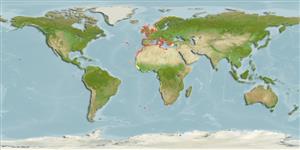Hexacorallia |
Scleractinia |
Caryophylliidae
Environment: milieu / climate zone / depth range / distribution range
Ecology
Reef-associated. Subtropical
Eastern Atlantic and the Mediterranean.
Length at first maturity / Size / Weight / Age
Maturity: Lm ? range ? - ? cm
The stony coral are not colonial. Vertical size skeleton reaches 0.25 mm, its section is round; at base not narrowed in normal conditions. End of the tentacles forming a small spherical bludgeon brown; white or pink polyps (Ref. 358).
Vertical skeleton size: 0.25 cm (Ref. 358). Habitat: Interior of underwater caves and anfractuosities, lower level of rock overhangs, bottom and walls of rock nature little exposed to the light species present of the small funds until greater depth (Ref. 358). Known from infra- and circalittoral zones (Ref. 85338).
Life cycle and mating behavior
Maturity | Reproduction | Spawning | Eggs | Fecundity | Larvae
Members of the class Anthozoa are either gonochoric or hermaphroditic. Mature gametes are shed into the coelenteron and spawned through the mouth. Life cycle: The zygote develops into a planktonic planula larva. Metamorphosis begins with early morphogenesis of tentacles, septa and pharynx before larval settlement on the aboral end.
Göthel, H. 1992 Guide de la faune sous-marine: La Méditerranée. Invertébrés marins et poissons. Eygen Ulmer GmbH & Co. 318 p. (Ref. 358)
IUCN Red List Status
(Ref. 130435: Version 2025-1)
CITES status (Ref. 108899)
Not Evaluated
Threat to humans
Human uses
| FishSource |
Tools
More information
Trophic EcologyFood items (preys)
Diet composition
Food consumption
Predators
Population dynamicsGrowthMax. ages / sizesLength-weight rel.Length-length rel.Length-frequenciesMass conversionAbundance Life cycleReproductionMaturityFecunditySpawningEggsEgg developmentLarvae PhysiologyOxygen consumption
Human RelatedStamps, coins, misc.
Internet sources
Estimates based on models
Preferred temperature
(Ref.
115969): 10.5 - 18.3, mean 12.2 (based on 114 cells).
Price category
Unknown.
